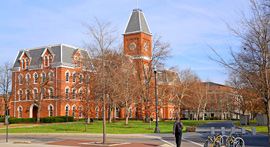Academics
The University of Massachusetts-Amherst is a large university with all the perks: “so much opportunity and so many different people to meet… both socially and academically.” Its status as the flagship of the UM system is well-earned: it’s not just the largest public research university in New England but also “a great institute… [with] an amazing faculty that wants to help you.” The 24,000 undergraduates (and 100+ majors) are also served by UMass being a part of the Five College Consortium, which allows access to a broader array of courses, academic resources, facilities, and libraries across five campuses in the Pioneer Valley. This scale means that some general education classes are very large, but students note that even here, they feel able to interact and network with professors, and they cite innovative approaches to keep things fresh (“Team-Based Learning classes where a large portion of the class is working with other students to solve problems”) or to help support students (“recording lectures and automatically transcribing them”).
The “teachers foster good learning environments” wherein they “try and connect with us on a personal level to make us feel more a part of the class.” A student says: “My architecture classes have built-in work times where my professors stay and give feedback during the process.” Faculty are “very aware of the world and how things connect” and provide a gateway to plenty of “internship opportunities and service learning courses.” Some professors “are very good at engaging students by using anecdotes and demonstrations,” and there are “wonderful opportunities and resources available to enhance learning.”
Student Body
The University of Massachusetts-Amherst is a collaborative environment where people “are extremely dedicated and hard-working students” and “everyone truly wants you to succeed with them.” Students suggest that the majority of students are in-state, but still “a diverse group that comes together to pursue their different goals.” One commonality, however, is “there are a lot of outgoing people here,” or as one student puts it: “everyone is very nice and it’s definitely a good community to be in.” In essence, it’s a “large student body so you meet a lot of people, but still small enough communities that you can make really good friend groups.” This “unique and smart” bunch is “open, kind, [and] welcoming” and “love to share who they are with everyone.” UMass students are also “very involved in campus and active members of the community” and “everyone is so willing to learn and cooperate in classes as much as possible.”
Campus Life
The school features a “great mix of social and academic life” and has the facilities to support both. The rec center offers classes that students admire, the Student Union provides plenty of opportunities for “volunteering in different events,” we’re told that “people love to go to the gym,” and many simply like to “hang with friends on my floor.” Intramurals and “lots of outdoor activities” are quite popular, from “sports such as flag football, softball and basketball, plus the LUG ice hockey league.” In short, as with the academics, there are “lots of resources, and lots of advertising of those resources” on the part of the school, and “so many options in regard to clubs, classes, and especially food.” No wonder, then, that students say they “mainly fill their days with classes and friendships.”




